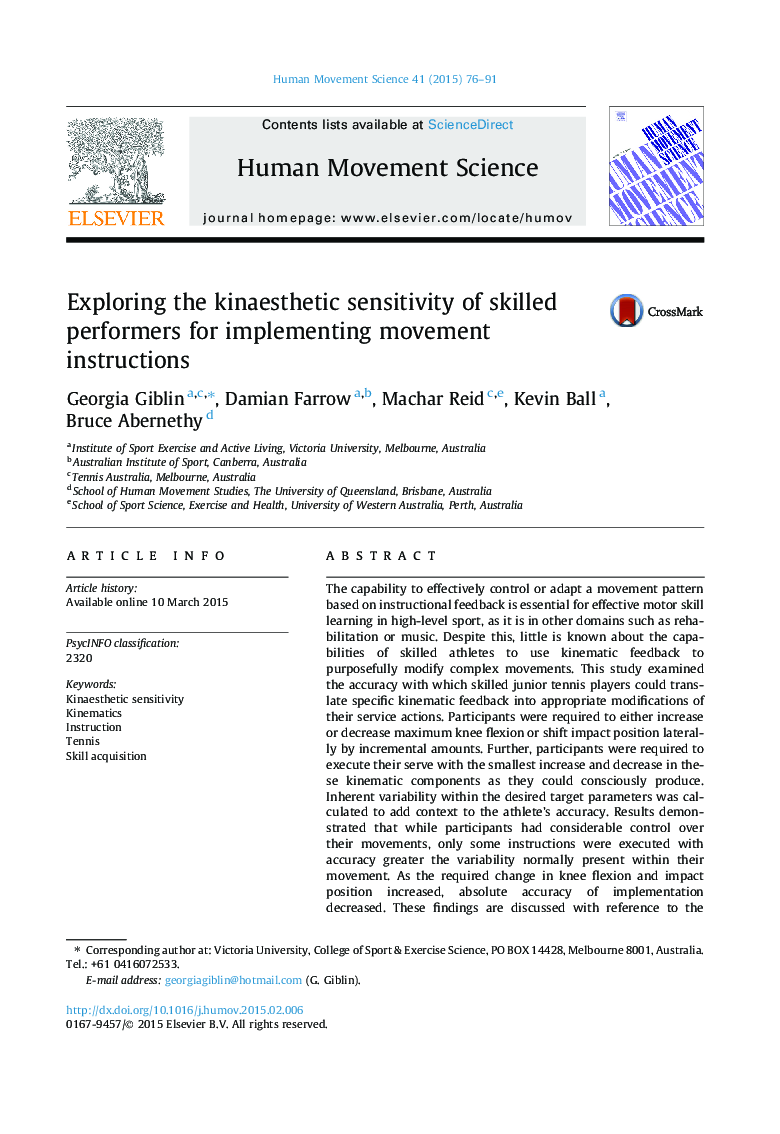| کد مقاله | کد نشریه | سال انتشار | مقاله انگلیسی | نسخه تمام متن |
|---|---|---|---|---|
| 7291957 | 1474224 | 2015 | 16 صفحه PDF | دانلود رایگان |
عنوان انگلیسی مقاله ISI
Exploring the kinaesthetic sensitivity of skilled performers for implementing movement instructions
ترجمه فارسی عنوان
بررسی حساسیت جنبشی هنرمندان ماهر برای اجرای دستورالعمل های حرکتی
دانلود مقاله + سفارش ترجمه
دانلود مقاله ISI انگلیسی
رایگان برای ایرانیان
کلمات کلیدی
ترجمه چکیده
توانایی به طور موثر کنترل یا انطباق یک الگوی حرکتی بر مبنای بازخورد آموزشی برای آموزش موثر مهارت های حرکتی در ورزش سطح بالا ضروری است، همانطور که در سایر حوزه ها مانند توانبخشی و یا موسیقی است. با وجود این، کمی در مورد توانایی های ورزشکاران ماهر برای استفاده از بازخورد جنبشی برای هدفمند تغییر جنبه های پیچیده شناخته شده است. در این مطالعه دقت بررسی شد که بازیکنان جوان تنیس ماهر می توانند بازخورد خاص سینماتیکی را به تغییرات مناسب در عملکرد خدمات خود انتقال دهند. شرکت کنندگان از افزایش یا کاهش حداکثر فلکانس زانو یا تغییر وضعیت تغییر در سمت چپ با افزایش مقادیر ضروری بودند. علاوه بر این، شرکت کنندگان مجبور بودند که خدمت خود را با کمترین افزایش و کاهش این اجزاء سینماتیک را به طور آگاهانه تولید کنند. تغییرات ذاتی در داخل پارامترهای مورد نظر مورد نظر محاسبه شده است تا زمینه را به دقت ورزشکار اضافه کند. نتایج نشان داد که در حالی که شرکت کنندگان کنترل قابل ملاحظه ای بر جنبش خود داشتند، تنها تعدادی از دستورالعمل ها با دقت بیشتری انجام شد و تغییرات معمولا در جنبش آنها وجود داشت. همانطور که تغییرات مورد نیاز در زانوی فلکسون و ضربه افزایش یافت، دقت مطلق اجرای کاهش یافت. این یافته ها با اشاره به کوچکترین تغییرات کنترل شده تولید شده توسط ورزشکاران و تغییرات در فعالیت های آنها مورد بحث قرار می گیرد.
موضوعات مرتبط
علوم زیستی و بیوفناوری
علم عصب شناسی
علوم اعصاب شناختی
چکیده انگلیسی
The capability to effectively control or adapt a movement pattern based on instructional feedback is essential for effective motor skill learning in high-level sport, as it is in other domains such as rehabilitation or music. Despite this, little is known about the capabilities of skilled athletes to use kinematic feedback to purposefully modify complex movements. This study examined the accuracy with which skilled junior tennis players could translate specific kinematic feedback into appropriate modifications of their service actions. Participants were required to either increase or decrease maximum knee flexion or shift impact position laterally by incremental amounts. Further, participants were required to execute their serve with the smallest increase and decrease in these kinematic components as they could consciously produce. Inherent variability within the desired target parameters was calculated to add context to the athlete's accuracy. Results demonstrated that while participants had considerable control over their movements, only some instructions were executed with accuracy greater the variability normally present within their movement. As the required change in knee flexion and impact position increased, absolute accuracy of implementation decreased. These findings are discussed with reference to the smallest controllable changes produced by the athletes and the variability within their actions.
ناشر
Database: Elsevier - ScienceDirect (ساینس دایرکت)
Journal: Human Movement Science - Volume 41, June 2015, Pages 76-91
Journal: Human Movement Science - Volume 41, June 2015, Pages 76-91
نویسندگان
Georgia Giblin, Damian Farrow, Machar Reid, Kevin Ball, Bruce Abernethy,
